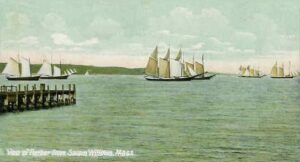
In 1761 Elias Hasket Derby, age 22, married Elizabeth Crowninshield, age 26. When they married, Elias’ father built them a brick house on Salem’s waterfront. Elizabeth’s father provided household items, including furniture, linen, brass kettles, and looking glasses. Elias acquired a new beaver hat to mark the occasion.
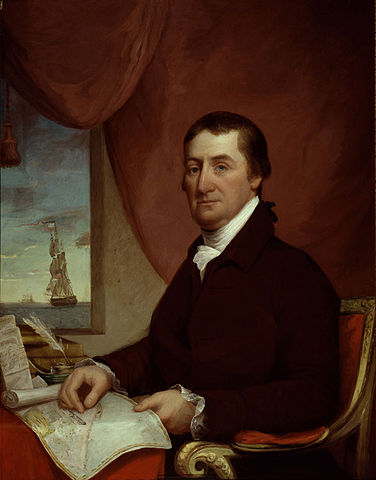
The couple were well-suited. The Derby family participated in the carrying trade with a spot of privateering during the French & Indian War (1756-1763). Elias ran the company from Derby Wharf. He employed young men as officers and crew aboard his ships, paid them well, and gave very precise instructions regarding they cargo they carried. The company prospered. When Elias died in 1799, he was one of the first millionaires in the United States.
The Crowninshield family was well-known in shipping and commerce, but in 1761 the Crowninshield youths worked for Elias Hasket Derby.
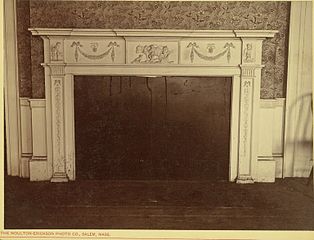
E. H. Derby acquired great wealth. His wife spent it, moving from the brick house on Derby Wharf to larger and larger homes. In 1780, she began building a mansion with glass from Holland and marble from Spain. Three years later, she abandoned this for a house on Washington Street where the family lived for 16 years. In 1795 work began on the ultimate Derby Mansion located on Essex Street. At the time it was unequaled for its architecture, gardens, and interior furnishings with imported glassware and Chinese porcelain. In 1799 the house was complete. Mrs. Derby had only weeks to enjoy it before she died. Her husband, a few months more.
Besides wealth and real estate, the Derby marriage produced three sons who lived to adulthood, and three daughters. Their marriages were of considerable importance to their parents. In the case of sons, it was important the avoid competing family interests. In the case of daughters, Elias Hasket Derby wanted their husbands to bring assets to the family business. All had served on Derby’s ships, but that wasn’t enough to make them proper husband material.
Miss Elizabeth Derby Marries Nathaniel West
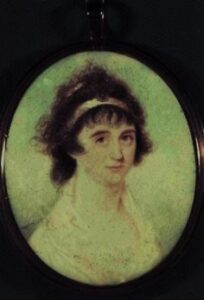
Elizabeth Crowninshield Derby West 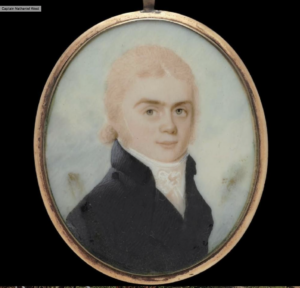
Nathaniel West
In 1783 at 21 years of age and against her parents wishes, Elias Hasket Derby’s eldest daughter married Nathaniel West. Elizabeth could have had her pick of any socially appropriate young man. Some sources say the courtship was, if not secret, less than public. The couple often met at the home of Elizabeth’s aunt. It’s unclear whether the marriage was public or an elopement.
Derby accepted the reality of his new son-in-law, giving him more responsibility in the business. No doubt he helped the young couple set up housekeeping. For Nathaniel, this was a great step up the social ladder. But for his bride, it was a social disaster.
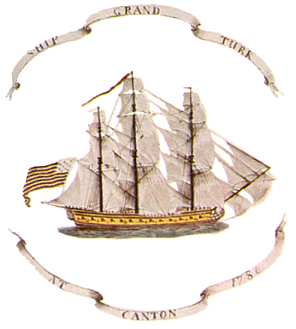
Once the daughter of the richest man in Salem, Elizabeth was now the wife of no-one particularly special. As appropriate for a matron of her perceived station, Elizabeth became active in charitable associations. She soon discovered her status was simply Mrs. West. As if that wasn’t enough, her name was now at the bottom of the membership roster. Elizabeth resigned from one organization, because the members didn’t elect her as ‘directress.’
The couple produced six children. Nathaniel West Jr was born in 1788. There were three daughters: Martha born in 1787; Eliza, born in 1790, and Sarah, born in 1797. I’ve yet to track down the other two sons. There was nothing overly remarkable about the West family until it fell apart.
On September 8, 1799, Elias Hasket Derby died. As the oldest daughter, Elizabeth expected to inherit the recently completed Derby Mansion. She was more than a little disappointed when the property went to her brother Elias Hasket Derby, Jr.
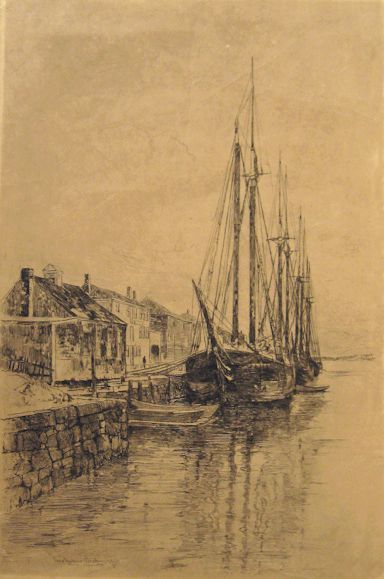
Nathaniel West may have been equally disappointed, either in not receiving the property or having to deal with his wife’s frustration. It is known that in 1800, Nathanial and his brother-in-law had a public fist fight on Derby Wharf. Shocking!
In fact, Elias Hasket Derby left his daughter and her husband a generous settlement. Elizabeth received one-seventh of her father’s real estate, Derby Wharf with docking privileges, the land under the store Nathanial erected on the wharf, and her father’s farm, Oak Hill, in nearby Danvers. Derby also forgave any outstanding debts Nathaniel owed to Derby personally, or to his estate.
Elizabeth immediately set out to improve the property at Oak Hill. When Rev. William Bentley paid a call in October 1801, he found ‘the apartments are finished in as good order as any I have ever seen. The furniture was rich, but never violated the chastity of correct taste. The pictures were excellent, the paper and linen hangings were superb. The moveable furniture; rich, uniform, but simple. The mirrors were large and gave full view of everyone who passed.”
The house was a showplace, but it wasn’t on Essex Square in Salem.
Two years later in October 1803, a surprising event occurred. Rev. Bentley reported that “a singular affair has happened in the family of the eldest daughter of Elias Hasket Derby, deceased. After a long quarrel, she has left her husband and taken up lodgings in town, and has become the ‘make game of the public spleen.’ This interests the pride of a very haughty family.”
Tongues are wagging, but the best gossip is yet to come.
⛵️⛵️⛵️
Illustrations
Salem Harbor. 1907 Postcard.
Elias Hasket Derby
Fireplace from Derby Mansion on Lafayette Street, Salem.
Derby Wharf, Salem by Charles Herbert Woodbury, 1889.
William Bentley. Diary of William Bentley.
Richard H McKey. Elias Hasket Derby of Salem, Massachusetts. 1961. Proquest.
Gordon D Ross. Crowninshield Family in Business & Politics. 1964. Proquest.

Sandra Wagner-Wright holds the doctoral degree in history and taught women’s and global history at the University of Hawai`i. Sandra travels for her research, most recently to Salem, Massachusetts, the setting of her new Salem Stories series. She also enjoys traveling for new experiences. Recent trips include Antarctica and a river cruise on the Rhine from Amsterdam to Basel.
Sandra particularly likes writing about strong women who make a difference. She lives in Hilo, Hawai`i with her family and writes a blog relating to history, travel, and the idiosyncrasies of life.


Wonderful! Bring on section two!
Same time next week. 🙂